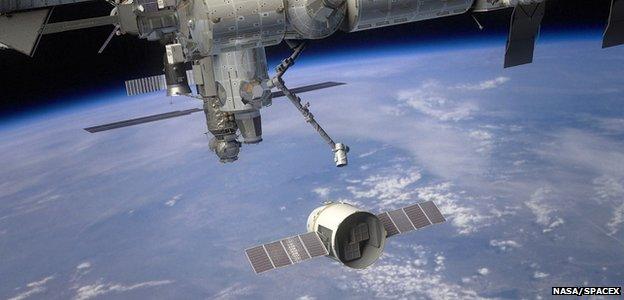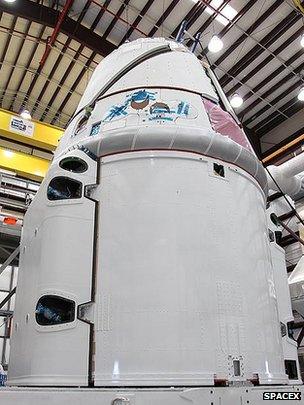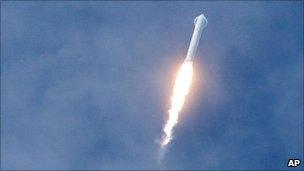SpaceX's Dragon ship set for station visit
- Published

Dragon will approach the station where it will be grabbed by a robotic arm
The first cargo resupply mission to the space station to be carried out by a commercial operator is likely to be on 30 April, the US space agency says.
The flight of the unmanned Dragon freighter is supposed to be just a demonstration, but its success would mark a new era in spaceflight.
Nasa is keen to hand off routine space transportation to the private sector - for both cargo and crew.
The upcoming mission will be performed by the SpaceX company of California.
It has been given tentative clearance to launch Dragon on 30 April at 12:22 EDT (16:22 GMT) from Cape Canaveral Air Force Station, Florida.
The date was confirmed during a Flight Readiness Review meeting attended by company personnel and Nasa officials on Monday.
Some final software checks are still being carried out and a more definitive "go, no-go" decision will be made next week.
Up and down
Elon Musk, the SpaceX chief executive officer and chief designer, urged people not underestimate the difficulty of building systems to go into orbit.
"It's just important to appreciate that this is pretty tricky," he told reporters.
"For the public out there, they may not realise that space station is zooming around the Earth every 90 minutes.

Dragon will stay at the station for a few weeks before returning to Earth
"It's going 17,000mph and you've got to launch up there and rendezvous. You've got to be tracking space station to within inches.
"This is something that's going 12 times faster than a bullet from an assault rifle. So it's hard."
Dragon will launch atop the company's own Falcon 9 rocket. Once beyond the atmosphere, the capsule will raise itself to the 390km-high International Space Station (ISS), where it will perform a number of communications, navigation and control systems tests.
Assuming these go well, the vessel will be permitted to move up alongside the station to be grabbed by a robotic arm.
This arm will then berth the capsule to the orbiting laboratory so that its stores of food and other consumables can be unloaded by the ISS astronauts. Attachment should occur on 3 May.
"We're always excited when we have a vehicle coming to ISS but this will be one of those historic launches," said Michael Suffredini, Nasa's ISS programme manager.
"This vehicle, even though it's a demo flight, will bring up 521kg of cargo to the ISS. We are going to utilise the flight for real hardware that is necessary for ISS. And we have about 660kg of cargo that will be returned."
But, given that SpaceX's systems are new and may not work properly, Mr Suffredini added: "We won't put anything on the vehicle we can't stand to not get home."
Crew carrier
Dragon has been developed under Nasa's Commercial Orbital Transportation Services, or COTS, programme, in which the agency has sought to seed fund cargo-carrying replacements for its recently retired shuttles.
SpaceX and another private company, the Virginia-based Orbital Sciences Corporation, have received hundreds of millions of dollars to help them develop new rocket and capsule systems.
Orbital is slightly behind SpaceX in its schedule but is still expected to fly to the station later this year.
Both companies, in addition to their COTS financing, have signed billion-dollar contracts with Nasa for multiple re-supply missions to the ISS in the years ahead.

SpaceX will be using the company-developed Falcon 9 rocket to get Dragon off Earth
"We wanted to place strategic financial investments to help stimulate the commercial space industry," said Alan Lindenmoyer, Nasa's COTS programme manager.
"We put some structure around those investments where we developed the programme to have the companies demonstrate these capabilities, with the goal of achieving safe, reliable and cost effective services. We were looking to help lower the cost of access to space."
SpaceX, though, is looking to carry more than just cargo. Its Dragon capsule has been designed in such a way that it can be modified to eventually carry humans.
The company is receiving further cash assistance in this respect through another of Nasa's projects called CCDev, or Commercial Crew Development.
Elon Musk said this modification could be achieved in the next three years.
The US government has taken the view that "straightforward" transportation to and from Low-Earth Orbit (LEO) should now be contracted out.
This approach should leave Nasa free to develop the systems needed to explore the Solar System.
To this end, Congress has approved plans for a huge rocket and sophisticated capsule to take humans far beyond the ISS, to destinations such as asteroids and even Mars.
Jonathan.Amos-INTERNET@bbc.co.uk and follow me on <link> <caption>Twitter</caption> <url href="https://twitter.com/#!/BBCAmos" platform="highweb"/> </link>
- Published10 April 2012
- Published20 March 2012
- Published10 May 2011
- Published29 April 2011
- Published5 April 2011
- Published8 December 2010
- Published8 December 2010